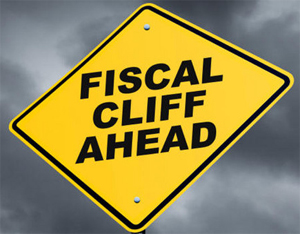
By Kevin Drawbaugh
WASHINGTON, Dec 27 (Reuters) – The long, bumpy road to America’s “fiscal cliff” on Dec. 31 has been traveled over many years by Congress and a series of U.S. presidents, including Democrat Barack Obama.
Some of the steps taken along the way had good intentions; some had no intention other than to put off hard decisions, while ideological divisions on fiscal policy steadily hardened.
On Thursday, Congress seemed to be headed toward another crucial deadline unable again to do much more than muddle through. And even that might be overly optimistic.
Here is a timeline of how the country got where it is:
* 1998-2001. Economic expansion of 1990s peaks. Government budget in surplus under Democratic President Bill Clinton.
* 2001. Stock market tech bubble bursts. Republican President George W. Bush and Congress enact deep tax cuts. Some Republicans predict cuts will spur economy, pay for themselves. Sept. 11 attacks. United States and allies invade Afghanistan.
* 2002. After four years of surpluses, U.S. budget slips into deficit of $158 billion. Bear market in stocks.
* 2003. United States and allies invade Iraq. Bush and Congress cut taxes further. Deficit grows to $378 billion.
* 2004-2006. Stock market recovers. Deficit shrinks.
* 2007-2008. Housing market bubble bursts. World financial crisis. Stock market crashes. Worst U.S. recession since Great Depression. Unemployment, home foreclosures soar. Bush, Congress bail out big banks. Deficit jumps to $459 billion in 2008.
* 2009. Obama, Congress enact $787 billion stimulus. Recession ends. Stocks bounce back. Deficit hits $1.4 trillion.
* 2010. Obama signs healthcare overhaul. Obama forms Simpson-Bowles deficit reduction panel. Its plan for fiscal reform is largely ignored. Republicans win control of House of Representatives. Obama agrees to extend Bush tax cuts for two years. Deficit shrinks to $1.3 trillion.
* 2011. Congress fights over Treasury Department request for increase in U.S. debt ceiling. Republicans, Democrats make peace by forming “super committee” to examine fiscal reform. Debt ceiling raised. U.S. credit rating downgraded. Super committee collapses. Deep, mandatory budget cuts triggered for 2013. Stock market makes choppy advance. Deficit estimated at $1.6 trillion.
* Spring 2012. Bernanke warns lawmakers of “massive fiscal cliff” at year-end of tax increases and spending cuts.
* Autumn 2012. Economists warn “fiscal cliff,” left unaddressed, could trigger recession. Obama reiterates support for keeping Bush tax cuts for all except high-income earners. Republicans support extension of Bush tax cuts for everyone. Deficit for 2012 estimated to shrink to $1.1 trillion.
* Nov. 6, 2012. Obama re-elected, Democrats keep control of Senate, Republicans keep control of House.
* Nov. 29. 2012. After Thanksgiving holiday and weeks of little action, White House releases its first offer in “fiscal cliff” negotiations. Republicans dismiss it.
* Dec. 3, 2012. House Republicans release counter-offer. Democrats dismiss it.
* Dec. 14-17. Obama and House Speaker John Boehner trade key concessions and appear headed for a compromise agreement.
* Dec. 18. Boehner walks away from talks with Obama, saying the president’s plan was not “balanced.” The speaker says House Republicans plan to pass a “Plan B” bill of their own.
* Dec. 21. Unable to gather enough votes from his own party for “Plan B,” Boehner abruptly adjourns Republican-controlled House for holidays. He says Obama and Democratic-controlled Senate must come up with compromise proposal.
* Dec. 27. Senate returns from holiday break with only four days remaining until the “cliff” arrives. House still on break.
* Dec. 31, 2012. If Congress takes no action, Bush tax cuts expire, other “fiscal cliff” elements begin to kick in.
* Early 2013. If no action from Congress, automatic budget cuts set to kick in. Debt ceiling expected to be hit again after Treasury Department runs out of ways to postpone it.



